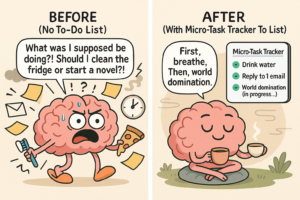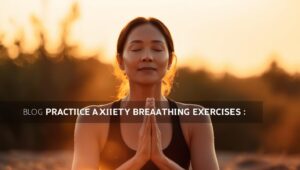How to Relieve Physical Symptoms of Anxiety: From Chest Tightness to Muscle Tension
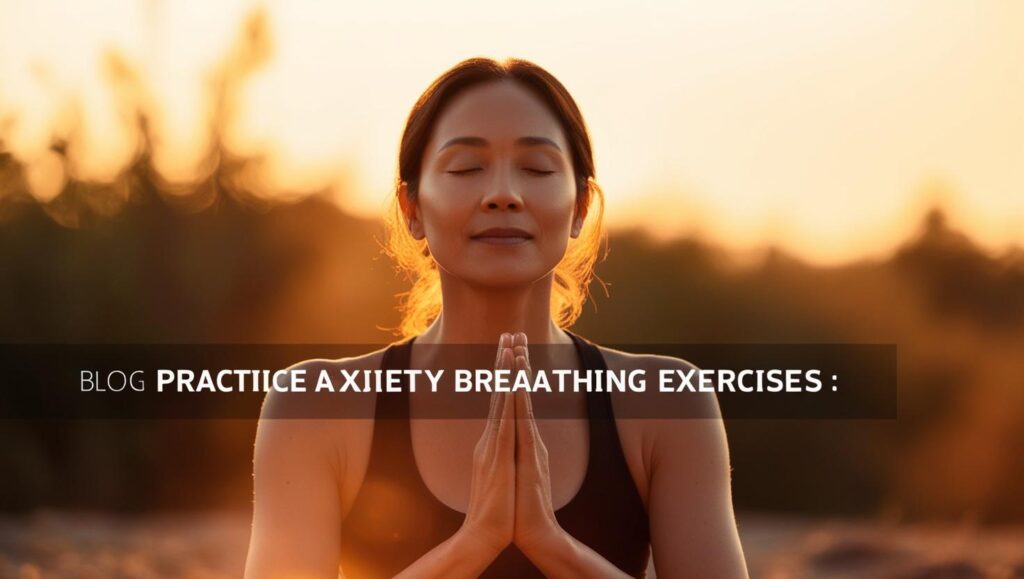
How to Relieve Physical Symptoms of Anxiety: From Chest Tightness to Muscle Tension
Anxiety doesn’t just live in your mind—it can take a toll on your body, too. From a tight chest that makes breathing feel impossible to knotted shoulders or a racing heart, physical anxiety symptoms can be overwhelming and exhausting. If you’ve ever wondered how to relieve anxiety in your chest or reduce muscle tension from anxiety, you’re not alone. These five practical, science-backed techniques—stretching, massage, breathing, acupressure, and heart rate reduction—can help you ease physical anxiety symptoms and reclaim your calm.
Feeling overwhelmed by tasks fueling your anxiety? Download the free Micro-Task Tracker Chrome extension or Firefox Add-On to simplify your to-do list and reduce stress.
Why Anxiety Shows Up in Your Body
 Anxiety triggers the body’s “fight or flight” response, flooding your system with stress hormones like cortisol and adrenaline. This can cause physical symptoms such as chest tightness, muscle tension, and a rapid heartbeat. According to a 2021 study in Frontiers in Psychology, these symptoms arise because your body is preparing to face a perceived threat, even if it’s just a stressful email or a crowded room. Left unaddressed, these physical anxiety symptoms can worsen, feeding a cycle of mental and physical discomfort.
Anxiety triggers the body’s “fight or flight” response, flooding your system with stress hormones like cortisol and adrenaline. This can cause physical symptoms such as chest tightness, muscle tension, and a rapid heartbeat. According to a 2021 study in Frontiers in Psychology, these symptoms arise because your body is preparing to face a perceived threat, even if it’s just a stressful email or a crowded room. Left unaddressed, these physical anxiety symptoms can worsen, feeding a cycle of mental and physical discomfort.The good news? You can break this cycle with targeted techniques that soothe your body and signal safety to your brain. Let’s explore five ways to relieve physical anxiety symptoms, from chest tightness to tense shoulders.
1. Stretching Routines for Neck and Shoulder Relief
Why It Works
Muscle tension from anxiety often settles in the neck and shoulders, causing stiffness and discomfort. Stretching releases this tension, improves blood flow, and promotes relaxation.
Simple Stretches
-
Neck Rolls: Slowly roll your head in a circle, 5 times clockwise and 5 times counterclockwise. Keep movements gentle to avoid strain.
-
Shoulder Shrugs: Lift your shoulders toward your ears, hold for 3 seconds, then release. Repeat 10 times.
-
Upper Trapezius Stretch: Tilt your head to one side, bringing your ear toward your shoulder. Hold for 20 seconds per side.
How to Do It
-
Spend 5-10 minutes daily, ideally in a quiet space.
-
Move slowly and breathe deeply to enhance relaxation.
-
Pair with soothing sounds, like my Black Screen Rain and Thunder video, to create a calming atmosphere.
Practical Tips
-
Stretch during work breaks to prevent tension buildup.
-
Use a warm towel on your shoulders before stretching to loosen muscles.
2. Massage Techniques and Tools
Why It Works
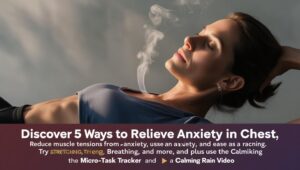 Massage reduces muscle tension from anxiety by relaxing tight tissues and boosting endorphins. A 2019 study in Journal of Clinical Psychiatry found that massage therapy significantly lowers anxiety-related physical symptoms.
Massage reduces muscle tension from anxiety by relaxing tight tissues and boosting endorphins. A 2019 study in Journal of Clinical Psychiatry found that massage therapy significantly lowers anxiety-related physical symptoms.Effective Methods
-
Self-Massage: Use your fingers to knead your neck and shoulders in circular motions for 5 minutes.
-
Foam Roller: Roll slowly over your upper back and shoulders to release knots. Spend 1-2 minutes per area.
-
Massage Gun: Apply a handheld massage gun to tense spots for 30-60 seconds, using low to medium settings.
How to Use Them
-
Set aside 10 minutes, 2-3 times weekly, for massage.
-
Follow with stretching for maximum relief.
Practical Tips
-
Apply a calming essential oil (e.g., lavender) during self-massage.
-
Invest in affordable tools like a $20 foam roller for home use.
3. Breathing Exercises to Relieve Chest Tightness
Why It Works
Chest tightness is a common physical anxiety symptom, often caused by shallow breathing during stress. Controlled breathing expands your diaphragm, eases tightness, and calms your nervous system.
Box Breathing Technique
-
Inhale through your nose for 4 seconds.
-
Hold your breath for 4 seconds.
-
Exhale through your mouth for 4 seconds.
-
Hold again for 4 seconds.
-
Repeat 4-6 cycles.
How to Do It
-
Practice for 2-3 minutes whenever chest tightness strikes.
-
Sit upright or lie down for optimal lung expansion.
Practical Tips
-
Use a guided breathing app like Calm for structure.
-
Practice proactively to prevent tightness during stressful moments.
4. Acupressure Points for Anxiety Relief
Why It Works
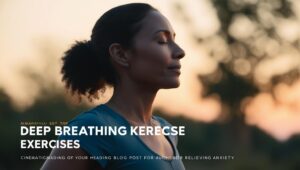 Acupressure applies pressure to specific points on the body to release tension and balance energy. A 2020 study in Complementary Therapies in Medicine found acupressure reduces anxiety and physical symptoms like muscle tightness.
Acupressure applies pressure to specific points on the body to release tension and balance energy. A 2020 study in Complementary Therapies in Medicine found acupressure reduces anxiety and physical symptoms like muscle tightness.Key Points
-
Pericardium 6 (Inner Wrist): Press the point 2 finger-widths from your wrist crease, between the tendons, for 1 minute per wrist.
-
Heart 7 (Wrist Crease): Press at the wrist crease, in line with your pinky, for 1 minute per side.
-
Yintang (Forehead): Gently massage the spot between your eyebrows for 30 seconds to calm racing thoughts.
How to Use Them
-
Apply firm but gentle pressure with your thumb or fingertips.
-
Practice for 3-5 minutes, focusing on slow breaths.
Practical Tips
-
Use in public settings, as it’s discreet and requires no tools.
-
Combine with aromatherapy for added calm.
5. Tips to Reduce Heart Rate During Anxiety
Why It Works
A racing heart is a hallmark of anxiety, driven by adrenaline. Cooling techniques and vagus nerve stimulation can lower heart rate quickly, per a 2018 study in Frontiers in Physiology.
Effective Methods
-
Cold Water Splash: Splash cold water on your face or hold a cold pack to your cheeks for 20-30 seconds to activate the dive reflex.
-
Vagus Nerve Stimulation: Hum softly or gargle water for 30 seconds to stimulate the vagus nerve, which slows heart rate.
-
Slow Breathing: Inhale for 4 seconds, exhale for 6 seconds, for 1-2 minutes.
How to Do It
-
Use these methods at the onset of a racing heart.
-
Repeat until your heart rate feels steady.
Practical Tips
-
Keep a small water bottle handy for quick splashes.
-
Practice humming during calm moments to build familiarity.
Conclusion: Soothe Your Body, Calm Your Mind
Physical anxiety symptoms like chest tightness, muscle tension, and a racing heart can feel debilitating, but you have the power to relieve them. With these five techniques—stretching, massage, breathing, acupressure, and heart rate reduction—you can address physical anxiety symptoms and create a sense of calm. Start with one method that resonates, and build a routine to keep anxiety at bay.
Ready to take control? Here’s how to begin:
-
Bookmark this post for quick access during anxious moments.
Which technique will you try first? Share in the comments, and pass this post along to someone who needs relief from physical anxiety symptoms!
